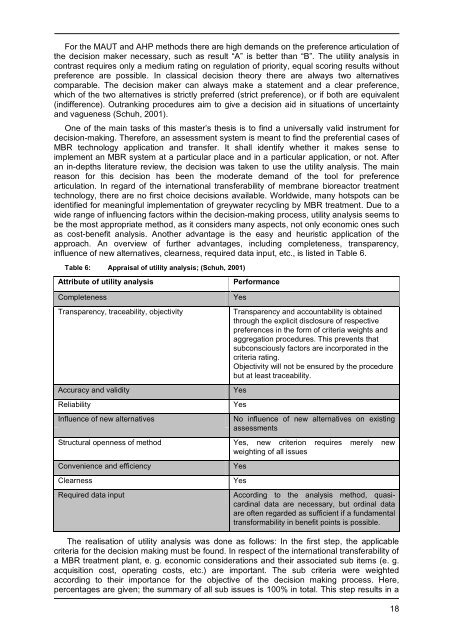An innovative greywater treatment system for urban areas ... - SuSanA
An innovative greywater treatment system for urban areas ... - SuSanA
An innovative greywater treatment system for urban areas ... - SuSanA
You also want an ePaper? Increase the reach of your titles
YUMPU automatically turns print PDFs into web optimized ePapers that Google loves.
For the MAUT and AHP methods there are high demands on the preference articulation of<br />
the decision maker necessary, such as result “A” is better than “B”. The utility analysis in<br />
contrast requires only a medium rating on regulation of priority, equal scoring results without<br />
preference are possible. In classical decision theory there are always two alternatives<br />
comparable. The decision maker can always make a statement and a clear preference,<br />
which of the two alternatives is strictly preferred (strict preference), or if both are equivalent<br />
(indifference). Outranking procedures aim to give a decision aid in situations of uncertainty<br />
and vagueness (Schuh, 2001).<br />
One of the main tasks of this master’s thesis is to find a universally valid instrument <strong>for</strong><br />
decision-making. There<strong>for</strong>e, an assessment <strong>system</strong> is meant to find the preferential cases of<br />
MBR technology application and transfer. It shall identify whether it makes sense to<br />
implement an MBR <strong>system</strong> at a particular place and in a particular application, or not. After<br />
an in-depths literature review, the decision was taken to use the utility analysis. The main<br />
reason <strong>for</strong> this decision has been the moderate demand of the tool <strong>for</strong> preference<br />
articulation. In regard of the international transferability of membrane bioreactor <strong>treatment</strong><br />
technology, there are no first choice decisions available. Worldwide, many hotspots can be<br />
identified <strong>for</strong> meaningful implementation of <strong>greywater</strong> recycling by MBR <strong>treatment</strong>. Due to a<br />
wide range of influencing factors within the decision-making process, utility analysis seems to<br />
be the most appropriate method, as it considers many aspects, not only economic ones such<br />
as cost-benefit analysis. <strong>An</strong>other advantage is the easy and heuristic application of the<br />
approach. <strong>An</strong> overview of further advantages, including completeness, transparency,<br />
influence of new alternatives, clearness, required data input, etc., is listed in Table 6.<br />
Table 6: Appraisal of utility analysis; (Schuh, 2001)<br />
Attribute of utility analysis Per<strong>for</strong>mance<br />
Completeness Yes<br />
Transparency, traceability, objectivity Transparency and accountability is obtained<br />
through the explicit disclosure of respective<br />
preferences in the <strong>for</strong>m of criteria weights and<br />
aggregation procedures. This prevents that<br />
subconsciously factors are incorporated in the<br />
criteria rating.<br />
Objectivity will not be ensured by the procedure<br />
but at least traceability.<br />
Accuracy and validity Yes<br />
Reliability Yes<br />
Influence of new alternatives No influence of new alternatives on existing<br />
assessments<br />
Structural openness of method Yes, new criterion requires merely new<br />
weighting of all issues<br />
Convenience and efficiency Yes<br />
Clearness Yes<br />
Required data input According to the analysis method, quasicardinal<br />
data are necessary, but ordinal data<br />
are often regarded as sufficient if a fundamental<br />
trans<strong>for</strong>mability in benefit points is possible.<br />
The realisation of utility analysis was done as follows: In the first step, the applicable<br />
criteria <strong>for</strong> the decision making must be found. In respect of the international transferability of<br />
a MBR <strong>treatment</strong> plant, e. g. economic considerations and their associated sub items (e. g.<br />
acquisition cost, operating costs, etc.) are important. The sub criteria were weighted<br />
according to their importance <strong>for</strong> the objective of the decision making process. Here,<br />
percentages are given; the summary of all sub issues is 100% in total. This step results in a<br />
18

















